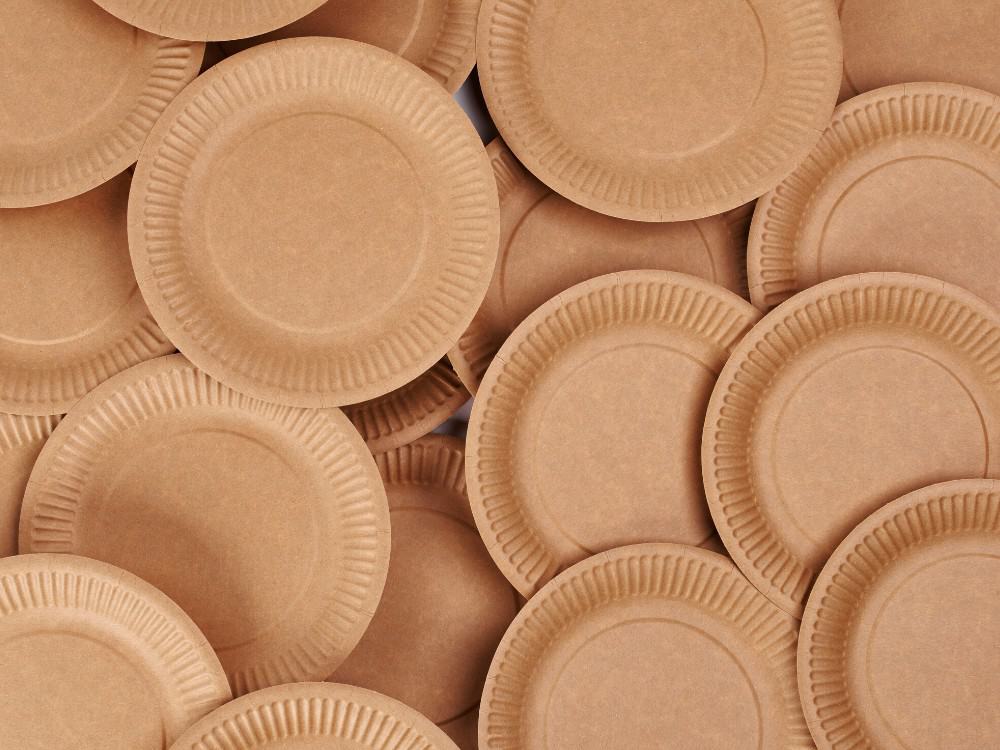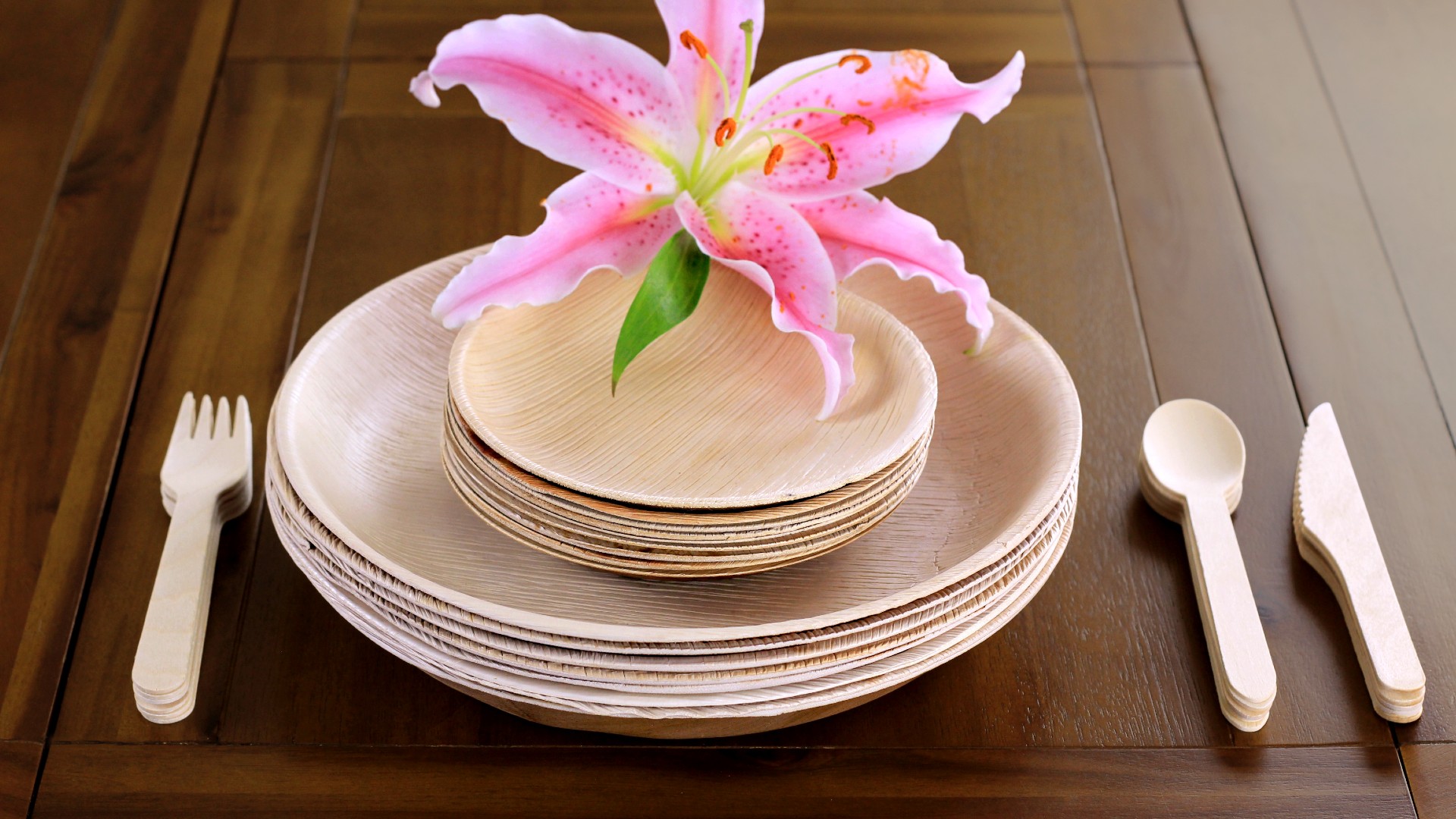
Disposable plates made of paper or plastic are convenient for outdoor gatherings, picnics, and parties, but they are also a major contributor to waste and pollution. Fortunately, there are alternatives to paper that can reduce their environmental impact.
One alternative to disposable plates is to use reusable plates made from materials such as bamboo, stainless steel, or ceramic. These materials are durable, long-lasting, and can be used over and over again, reducing the amount of waste generated from single-use plates. They can also add a touch of elegance to any event and are available in a variety of colors and designs to match any occasion.
Another alternative is to use compostable plates made from natural materials such as sugarcane, wheat straw, or bamboo. These plates can break down naturally in a composting facility, leaving no harmful residues behind. They are also sturdy and can hold hot and cold foods, making them a great option for outdoor events.
If disposable plates are a must, choose ones made from recycled materials such as paper or cardboard. These plates are made from post-consumer waste, reducing the amount of waste going into landfills. Additionally, some companies make plates out of recycled plastic, which is a way to give new life to waste plastic that might otherwise end up in the ocean.
Eco-friendly alternatives for paper plates

Paper plates are a popular choice for outdoor events such as parties and picnics, but they are not necessarily environmentally friendly. Thankfully, there are several eco-friendly alternatives to paper plates that may aid in waste reduction and encourage sustainable living.
Reusable plates are a simple and environmentally friendly alternative to paper plates. Pick plates made of long-lasting materials like bamboo, stainless steel, or ceramic. These plates are durable, may be washed and reused several times, and are dishwasher safe.
Compostable plates manufactured from natural materials such as sugarcane, bamboo, or wheat straw are another environmentally beneficial choice. These plates decompose organically in a composting facility, leaving no hazardous leftovers. They are also strong and can store both hot and cold meals.
Palm leaf plates are constructed from fallen palm leaves that have been gathered, cleaned, and molded into plates. They are strong, appealing, and biodegradable.
Areca nut plates are manufactured from the Areca palm tree’s leaves. These plates are biodegradable and compostable, and they are available in a range of sizes.
Edible plates created from rice, wheat, or maize are a one-of-a-kind and environmentally friendly solution. These plates may be consumed alongside the food, which eliminates the need for waste.
Using leaves as plates is an ancient and ecological approach that has been utilized for ages in many civilizations. Washing and using banana, lotus, or grape leaves as plates reduces waste and promote sustainability.
Alternatives to disposable paper plates

These sustainable alternatives are both durable and compostable, making them a more eco-friendly option.
Bamboo plates are made from the fast-growing, renewable bamboo plant and are both lightweight and durable. They are also naturally antimicrobial, making them a hygienic choice for food service. After use, bamboo plates can be washed and reused, reducing waste and promoting sustainability.
Bagasse plates are made from the fibrous residue left over after sugarcane juice extraction. They are sturdy and heat-resistant, making them a great option for hot and cold food items. Bagasse plates are also compostable and can be disposed of in commercial composting facilities or home composting systems.
Palm leaves make the best eco-friendly disposable plates

While palm leaves can make excellent eco-friendly throwaway plates, it is crucial to realize that not all palm leaf plates are made equal in terms of sustainability and ethics.
Palm leaf plates are manufactured from fallen areca palm tree leaves that are gathered and pressed into plates without the use of chemicals or additives. These plates are biodegradable and compostable, making them a more environmentally friendly alternative to throwaway plates.
But, be certain that the palm leaf plates you use are ethically and sustainably obtained. Some enterprises may utilize unsustainable harvesting methods or child labor to acquire palm leaves. Check for Fair Trade or Rainforest Alliance certifications to verify that the palm leaf plates are supplied responsibly and ethically.
Also, while palm leaf plates might be a terrific alternative for parties and celebrations, they are neither microwave nor dishwasher-safe. They should be composted at professional composting facilities or at home using home composting systems.
Top 10 Single-Use Plastics Destroying the Planet and Eco-Friendly Alternatives
Here are some eco-friendly alternatives to the top 10 single-use plastics that are polluting the planet:
- Disposable Plastic Plates – Use reusable plates made of glass, ceramic, or metal instead. There are also biodegradable and compostable plates made from plant-based materials like bamboo, wheat straw, or sugarcane bagasse.
- Plastic Water Bottles – Carry a reusable water bottle made from stainless steel, glass, or BPA-free plastic. You can also install a water filtration system at home to purify tap water.
- Disposable Plastic Trays – Bring your own containers to pack food or buy biodegradable or compostable containers made from cornstarch or sugarcane.
- Plastic Cups (Especially Coffee Cups) – Carry a reusable cup or mug made from ceramic, glass, or stainless steel. Some coffee shops even offer discounts for bringing your own cup.
- Disposable Plastic Bowls – Use bowls made from bamboo, sugarcane bagasse, or wheat straw. You can also use reusable bowls made from ceramic, glass, or metal.
- Plastic Shopping Bags – Bring your own reusable shopping bags made from cotton, jute, or recycled materials. Some grocery stores also offer paper bags or biodegradable bags made from plant-based materials.
- Plastic Cutlery – Use reusable cutlery made from bamboo, metal, or wood. You can also carry a spork or a set of utensils in your bag.
- Plastic Balloons – Instead of releasing balloons celebrate with other eco-friendly decorations like paper streamers or banners made from recycled materials.
- Plastic Containers – Use glass or metal containers for food storage. You can also use silicone bags or beeswax wraps to store food without using plastic.
- Plastic Straws – Use reusable straws made from bamboo, metal, or glass. You can also drink directly from the cup or buy biodegradable straws made from plant-based materials.
Various Types Of Disposable Plates You Can Switch To, Leaving Plastic Plates Behind

If you want to avoid plastic plates, there are various eco-friendly and sustainable alternatives available on the market. Here are some types of disposable plates you can switch to:
Biodegradable Plates – Made from plant-based materials like sugarcane bagasse, bamboo, wheat straw, or cornstarch, these plates are compostable and will decompose within a few months.
Paper Plates – Made from recycled paper, these plates are biodegradable and compostable. They are also more affordable than other eco-friendly options.
Palm Leaf Plates – Made from naturally fallen Areca palm leaves, these plates are durable, compostable, and have a rustic, natural look.
Wooden Plates – Made from sustainably sourced wood like birch, these plates are biodegradable and have a unique, earthy texture.
Stainless Steel Plates – Reusable and durable, stainless steel plates are a great option for outdoor picnics or camping trips. They are also easy to clean and can last a lifetime.
Glass Plates – Reusable and elegant, glass plates are perfect for formal dinners or special occasions. They are also easy to clean and can be used again and again.
By choosing any of these eco-friendly alternatives, you can reduce your plastic waste and help protect the environment.
Why (Most) Paper Plates Can’t Be Recycled
While paper plates are biodegradable and compostable, they are often not recyclable due to the way they are made. Here are some reasons why most paper plates cannot be recycled:
Coated with plastic or wax – Most paper plates are coated with a layer of plastic or wax to prevent liquids from seeping through. This coating makes them difficult to recycle as it contaminates the paper fibers and cannot be separated during the recycling process.
Low-quality paper – Many paper plates are made from low-quality paper, such as recycled paper, which is difficult to recycle. The fibers in the paper are shorter and weaker, making them unsuitable for recycling into new paper products.
Food residues – Paper plates are often used to serve food, and any food residues left on the plate can contaminate the recycling process. Food residues can attract insects and bacteria, leading to unpleasant odors and health hazards.
Small size – Paper plates are usually small and lightweight, making them less economical to recycle. Recycling facilities often require a large volume of material to justify the cost of processing.
While some paper plates may be recyclable, it’s essential to check with your local recycling facility to see if they accept them. If not, you can opt for eco-friendly alternatives like biodegradable plates made from plant-based materials or reusable plates made from stainless steel or glass.
They’re Coated in Wax, Plastic, or Clay
Many paper plates are coated with a layer of wax, plastic, or clay to make them waterproof and grease-resistant. The coating helps to prevent liquids and oil from soaking through the plate and causing it to weaken or collapse. However, this coating makes the plates difficult to recycle and often ends up in landfills or incinerators, contributing to pollution and greenhouse gas emissions.
Wax-coated paper plates are made by applying a thin layer of paraffin wax to the surface of the paper. This wax coating makes the plates waterproof and helps to prevent them from becoming soggy or disintegrating when they come into contact with liquids.
Plastic-coated paper plates are made by laminating a layer of plastic film onto the surface of the paper. The plastic film makes the plates more durable and resistant to tearing or breaking. However, this coating also makes the plates difficult to recycle, as the plastic film cannot be easily separated from the paper fibers.
Clay-coated paper plates are made by applying a layer of kaolin clay to the surface of the paper. This clay coating makes the plates more resistant to moisture and oil, and also gives them a smooth, glossy finish. However, the clay coating also makes the plates less recyclable, as it can contaminate the paper fibers and interfere with the recycling process.
To avoid using disposable plates coated with wax, plastic, or clay, you can choose eco-friendly alternatives made from plant-based materials or reusable plates made from durable materials like stainless steel or glass.
They’re Contaminated With Food Waste
Another reason why paper plates are often not recyclable is. When paper plates are used to serve food, they can become contaminated with food waste, grease, and oils. This contamination can make the paper plates unsuitable for recycling as the food residues can attract insects and bacteria, causing unpleasant odors and health hazards.
When paper plates are recycled, they are mixed with water to create a pulp that is then used to make new paper products. However, if the paper plates are contaminated with food waste, it can affect the quality of the recycled pulp and lead to problems during the papermaking process.
To avoid contaminating paper plates with food waste, you can take the following steps:
Avoid using paper plates for greasy or oily foods, as these are more likely to leave residue on the plate.
Try to use reusable plates or eco-friendly alternatives like biodegradable plates made from plant-based materials.
If you must use paper plates, make sure to dispose of them properly by scraping off any food waste and placing them in the compost bin if possible.
By taking these steps, you can help to reduce waste and protect the environment.
Leave a Reply